So what do I even mean by neck construction? Well, have you ever noticed that some Rickenbacker necks are “striped” and some aren’t? Or that the stripes on some are wider than the stripes on others? What’s that all about?

Well that’s what we’re gonna go into here. And once you understand it all—what the stripes (or lack thereof!) mean, what happened when—well, that’s one more tool in your toolbox to help you date a guitar without a serial number.
So let’s begin with something that has nothing to do with how the neck is built. And that is how the neck is attached to the guitar. There’s three basic methods, all of which Rickenbacker has used:
Bolt-on. Exactly what it sounds like. The neck is a separate part that is attached to the body with screws or bolts.

Set. The neck is again a separate part, but instead of bolts or screws it is glued into place on the body.
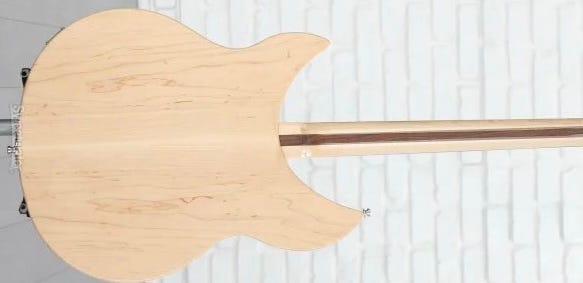
Through. The neck is an integrated part of the body that runs the entire length of the guitar—from the headstock to the base—with the “wings” of the body attached to it.
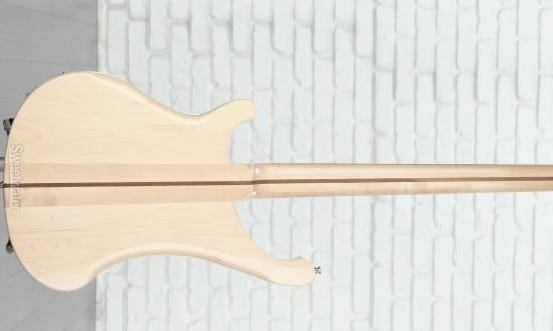
Got it? So the next question is how many pieces of wood are used in the neck? It could be one piece, or multiple pieces. If multiple pieces are used, and they are different types/colors of wood, that’s what creates the “stripes” we were talking about earlier.
And note here that while we will talk about the headstock wings—the pieces of wood that are added to make the headstock wider than the neck—those pieces are not counted when we talk about how many pieces go into the neck. Because they don’t—they’re only on the headstock. Got it?
OK. Let’s do this. The very first “modern” electric Rickenbackers—the Combo 600 and Combo 800 introduced in 1954 had one piece maple necks with maple headstock wings that were attached to the body with one (!) bolt.
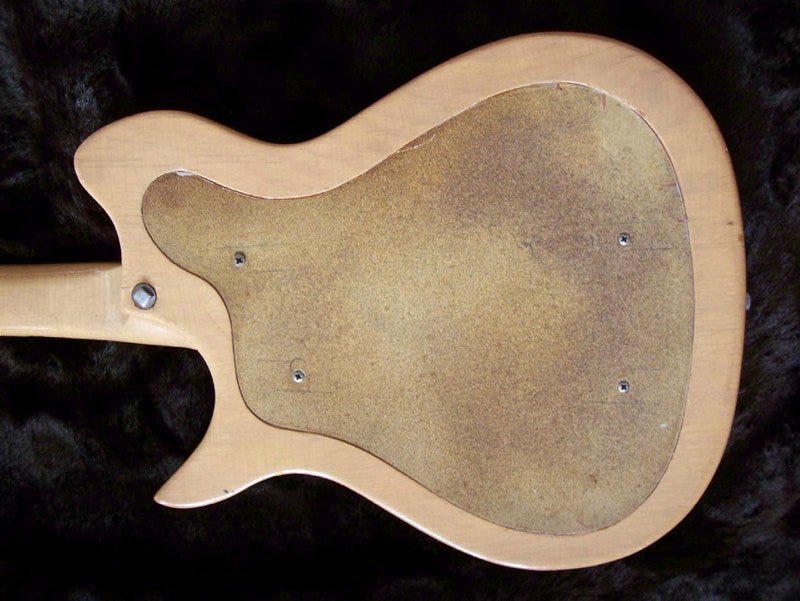
Now, there is some debate as to whether these two guitars should be called solidbodies or semi-hollowbodied. TECHNICALLY, they are indeed semi-hollowbodies, as a significant amount of material was removed from the back as you can see from the photo below, and then covered by a metal plate.
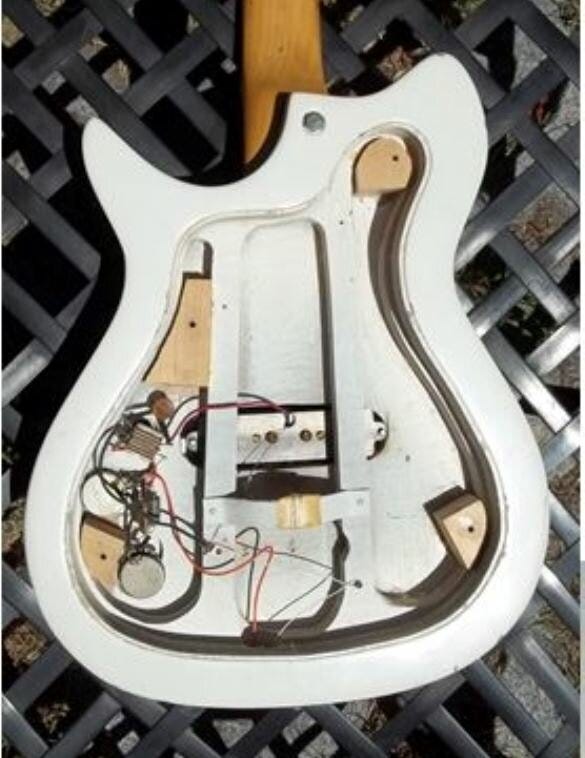
But this was not really done for any “resonant” purpose. In today’s terms I would argue we’d call this “weight relieved” as opposed to semi-hollow.
All this is a long way of saying that while these are indeed technically semi-hollowbodies, I’M gonna call them “weight relieved solidbodies” for the purpose of this statement right here: “With the introduction of the Combo 600 and 800 in 1954, Rickenbacker began the practice of using one piece maple necks on solidbody guitars—a practice that continues to this day.”
I’ll add to that: “One piece guitar necks, whether bolt on, set, or through, usually have headstock wings made of the same material as the neck, with a few exceptions.”
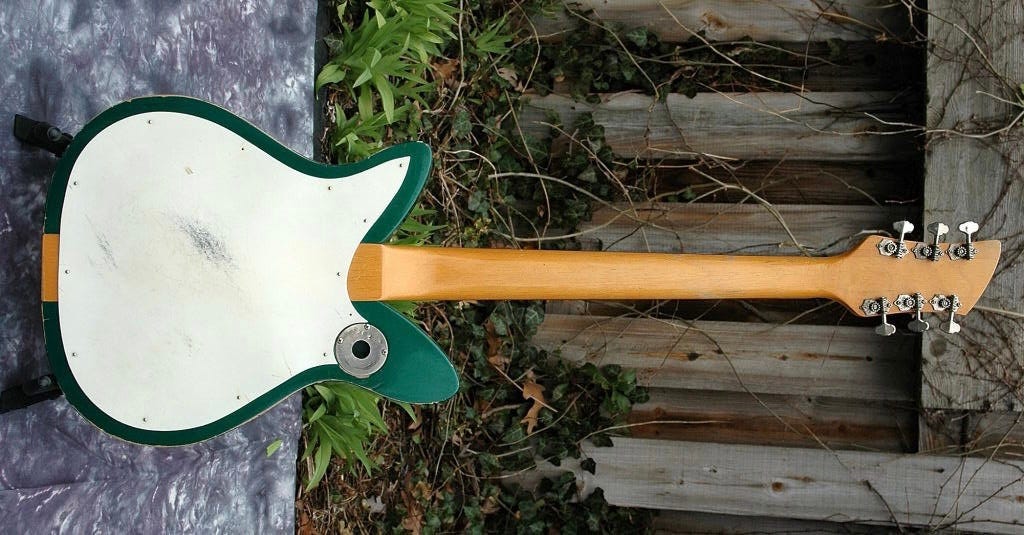
Got it? If it’s a solidbody guitar, it most likely has a one piece maple neck with maple headstock wings. So what are the exceptions to this rule?
Well, from 1958-1961 most solidbodies had one piece necks—with a couple exceptions we’ll talk about below—but with walnut wings rather than maple.
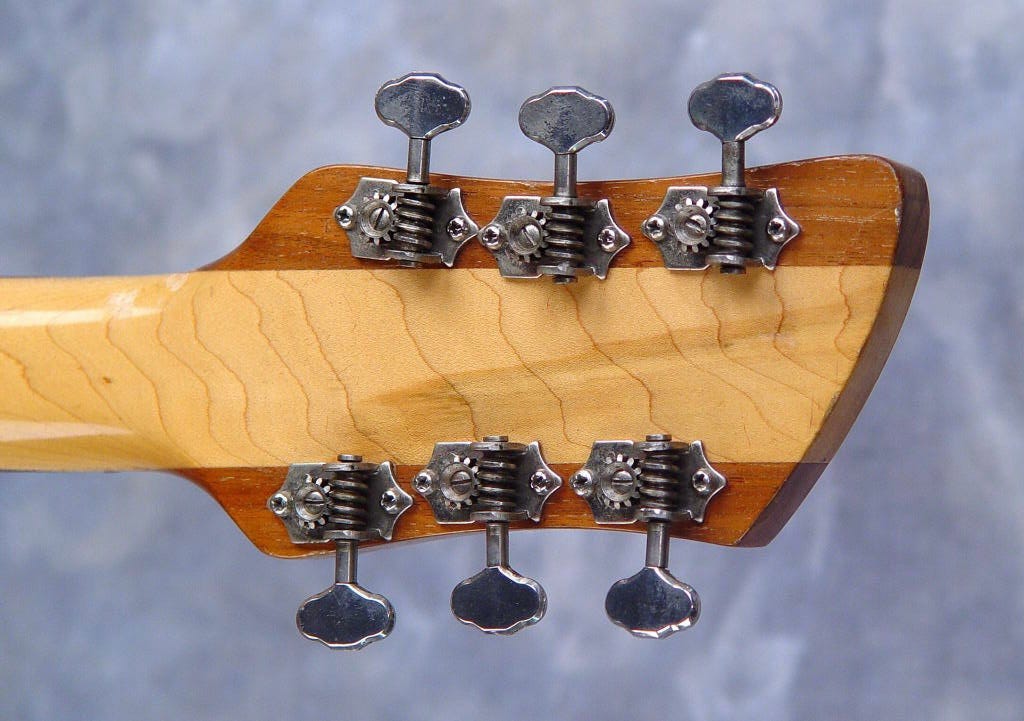
That’s one. But by 1962 maple wings was the standard.
The 660 (both the Tom Petty Signature Limited Edition and the garden variety) had a one piece maple neck with walnut headstock wings from launch in 1991 until 2009.
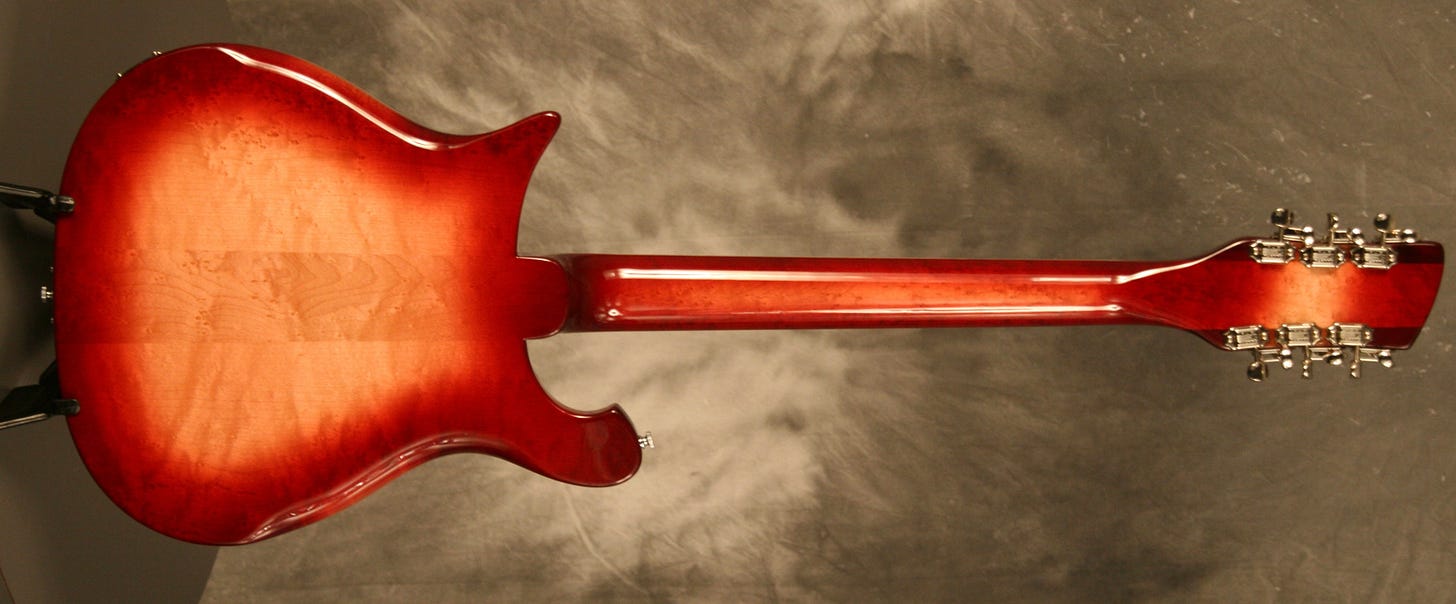
So there’s your first exception to the rule in a long time! In 2009, however, the neck became TWO pieces with a center seam, both maple, again with the walnut wings, and remains thus to this day.
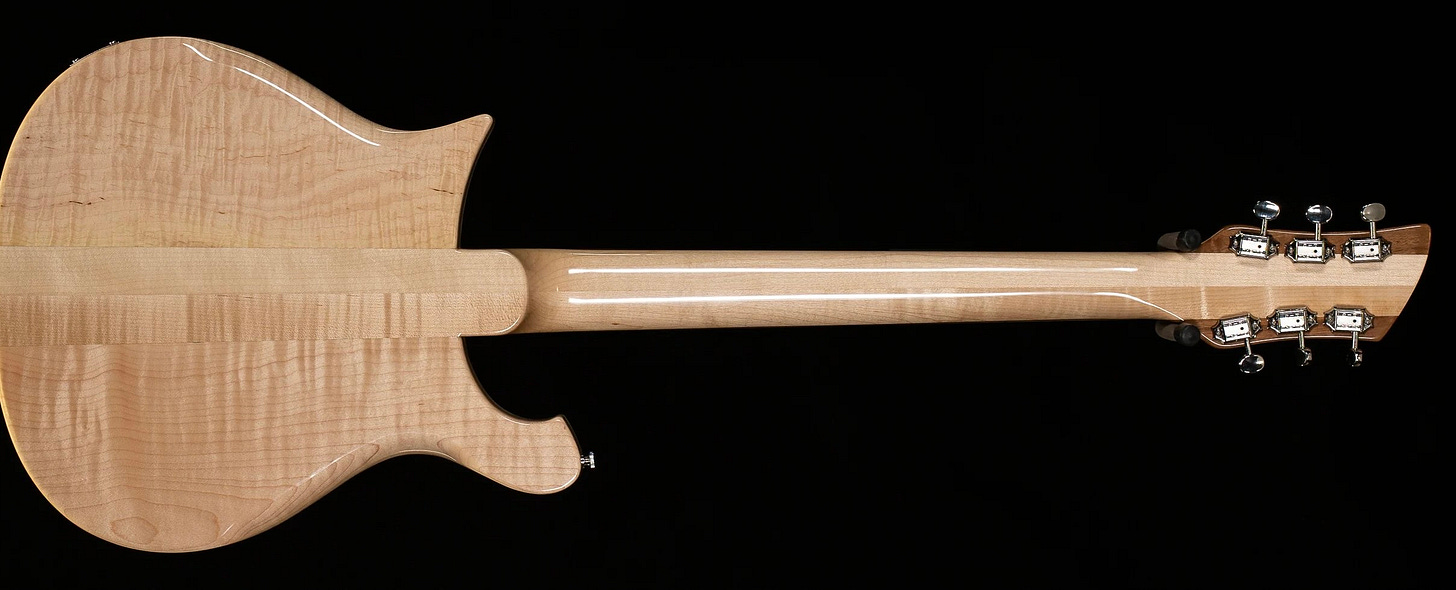
Then there’s the 650 series of guitars. There were five variants: the 650A Atlantis, 650C Colorado, 650D Dakota, 650S Sierra, and 650E/F Exacalibur/Frisco (the name changed due to trademark issues). The Atlantis and Colorado had maple headstock wings, but the Dakota and Sierra had walnut headstock wings and the Excalibur/Frisco had vermillion wings. And, like the 660, they too changed from one piece maple necks to two piece center seamed maple in 2009.
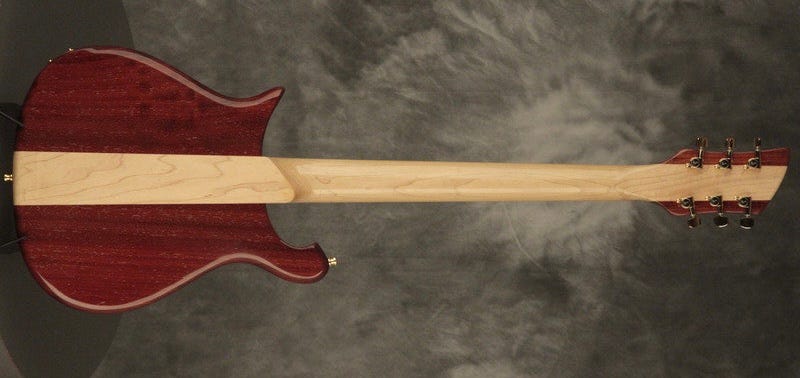
So 2009 is important, no? Sure is. Because that same year the 620–which in all of its variants (610, 615, 625, 12 strings) from its launch in 1962 up to that point had come with a one piece maple through neck with maple wings ALSO got a two piece maple center seam neck. You can say “stronger” or you can say “cheaper”…and you probably know which one is right.
But there’s one more exception we need to talk about: the Combo 650 and 850. Produced in very low numbers in 1958 and 1959, the production solidbody set neck guitars featured the standard one piece maple with maple wings necks, but a handful of show guitars were produced with three piece maple/walnut/maple necks with walnut wings—which we’re going to talk about when we get to the semi-hollowbody guitars.
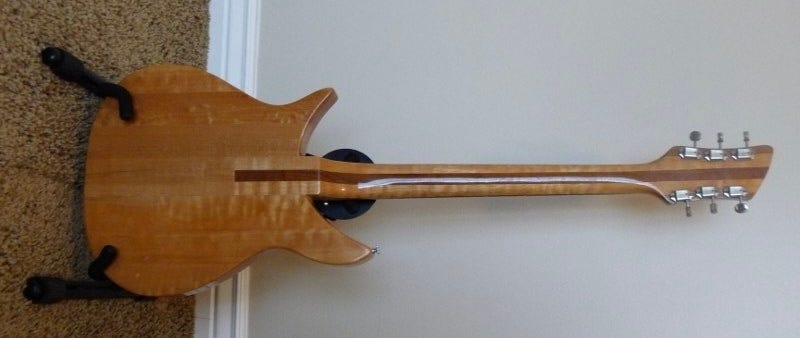
So we can now refine and combine our original statements as follows: “With the introduction of the Combo 600 and 800 in 1954 Rickenbacker began the practice of using one piece maple necks on solidbody guitars. This changed to two piece maple necks in 2009. Headstock wings on these necks, whether bolt-on, set, or through are—with the exception of the period 1958-1961, the model 660, and some of the 650 series guitars—also maple. Some Combo 650 and 850s, however, utilized a three piece maple/walnut/maple neck with walnut headstock wings”.
Done. So what about the semi-hollowbodies? Well, let’s begin with another blanket statement, and then refine it: “The very first semi-hollowbodied guitars introduced in 1958 in both 24 3/4” scale and 20 3/4” short scale featured one piece maple necks with maple wings like the solidbodied guitars that had come before.”
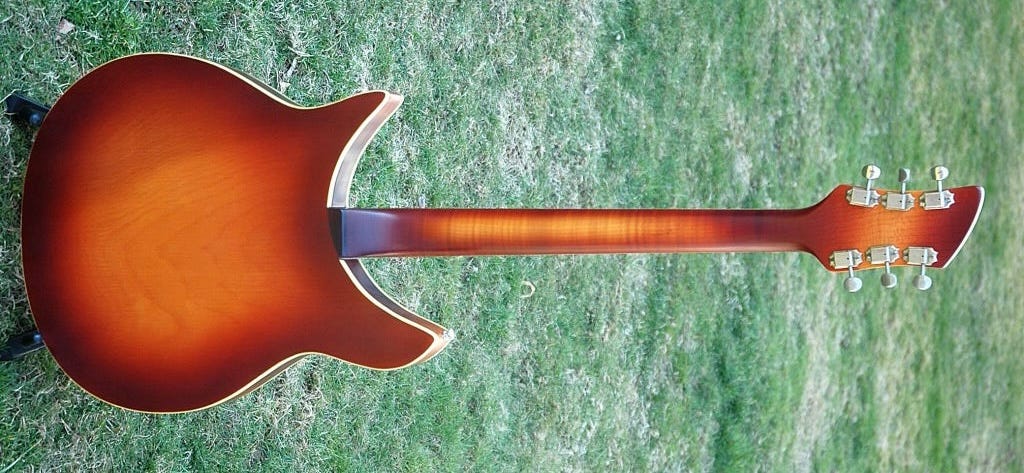
“But by early 1959 they had standardized around three piece maple/walnut/maple necks with walnut headstock wings for 24 3/4” scale guitars and one piece maple necks with maple headstock wings for the 20 3/4” short scale guitars.”
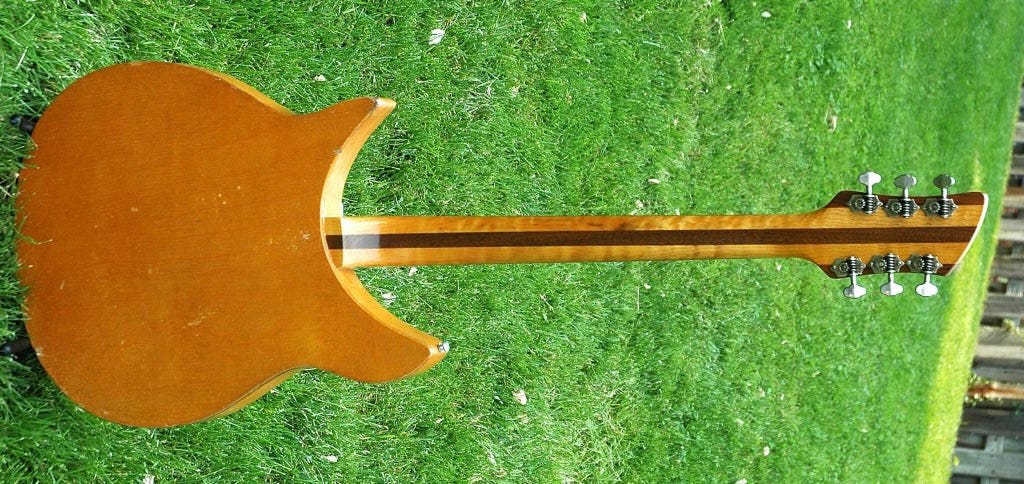
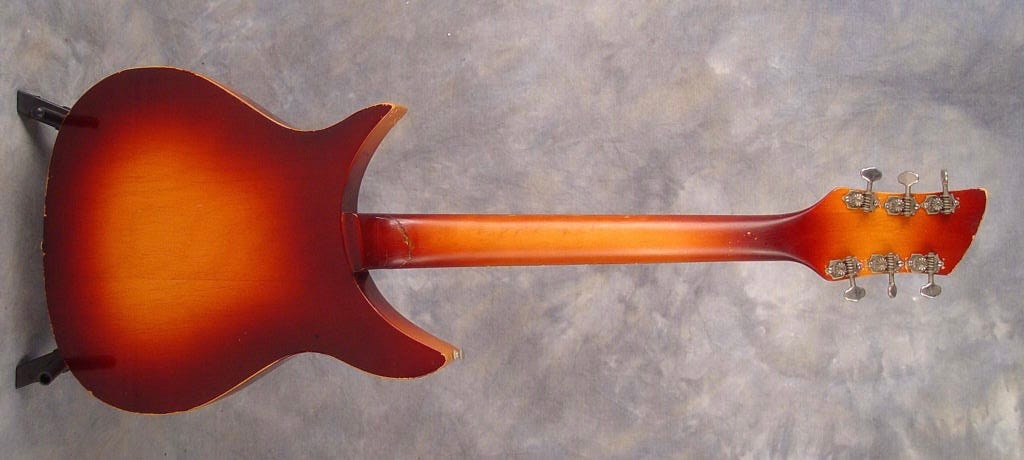
“With a few exceptions, this system remains in place for semi-hollowbodied guitars to this day.”
Before we go any further, we need to spend a minute on “walnut”. Per John Hall, that center stripe has not always been walnut. At various times—and I can find no specifics here—the company has used walnut, shedua, and even rectified (a process similar to torrefaction) maple for the center stripe. Since they are visually similar and no authoritative timeline exists, we’re just going to refer to the center stripe as “walnut”.
OK, so what are the exceptions here? Well, there’s three exceptions I can think of off the top of my head
The first is the 331 Light Show. Produced from 1971-1972 this oddity featured a one piece maple neck with maple wings.

The second is the 1993 Plus. Like its wider-necked brethren the 650 and 660, the 1993 Plus features a 2 piece (because it was launched after 2009) center seamed maple neck with walnut headstock wings.
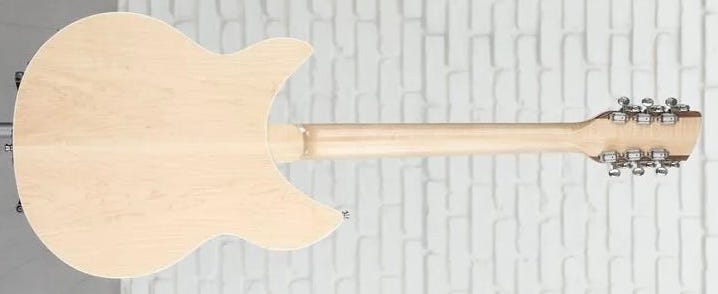
And finally is the 350 Liverpool and 350V63. From the 350’s launch in 1983 to mid 2006, the 350/350V63 featured one piece maple necks with maple headstock wings. In mid 2006 this changed to standard semi-hollow three piece maple/walnut/maple with walnut headstock wings.
But there’s more to the story than that. Because while semi-hollowbodies have always had the 3 piece neck, for a significant period of time the center walnut stripe got smaller.
Historically, the center walnut piece was roughly the same width as the two outer maple pieces—about .625 inch/1.6 cm. You could get some slight variation in size, but it was always in that ballpark. But that would change dramatically in the 1973/1974 timeframe when it roughly halved in size to about .3125 inch/.79 cm.
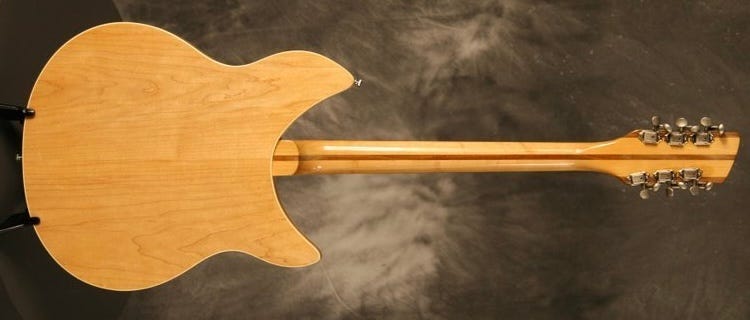
Why? Well you can find the theory online that it had something to do with strengthening the headstock on the 12 string by moving the slot out of the joint between the maple and the walnut, but c’mon. The most likely answer is that hard maple is about half the price per board foot of walnut.
The 4000 series basses had added a similarly sized shedua “skunk stripe” to their previously one-piece neck a couple years before (and we’ll talk about that in a minute), so it was a consistent look, at least. But it would stay that way until long after the basses had dropped the stripe and gone back to one piece necks.
It wouldn’t be until 1997, in fact, that the center walnut piece reverted back to the original 5/8ths width. It looked smaller because of the large paddle headstock currently in use, but it was back to where it had started. Once the headstock shrunk in 2008 it looked more or less like it had in 1972. And that’s how the neck has been ever since.
So let’s revise our original overview with what we’ve learned: “The very first production semi-hollowbodied guitars, introduced in 1958 in both regular 24 3/4” scale and 20 3/4” short scale featured one piece maple necks with maple wings like the solidbodied guitars that had come before. But by the end of 1958 they standardized around three piece maple/walnut/maple necks with walnut headstock wings for 24 3/4” scale guitars and one piece maple necks with maple headstock wings for the 20 3/4” short scale guitars. From 1973-1996 the center walnut piece was halved in width, but it returned to the pre-1973 width in 1997. With the exception of the 331, which featured a one piece maple neck with maple headstock wings and the 1993 Plus, which featured a two piece maple neck with walnut headstock wings, all semi-hollowbody guitars have followed this standard to this day.”
Cool. Now let’s talk basses! So here’s our first pass overview: “While early 4000 basses produced between 1958 and 1959 featured one piece mahogany through necks with mahogany headstock wings,”
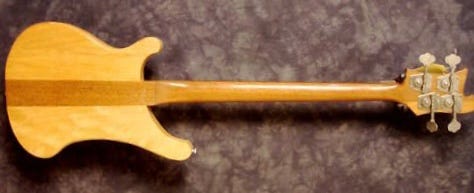
“by late 1959 they standardized around a one piece through maple neck with walnut headstock wings.”

“This would remain the solidbody 4000 series standard until 1972 when construction changed to three piece, with a narrow shedua strip often referred to as a “skunk stripe” sandwiched between two maple pieces and maple headstock wings.”
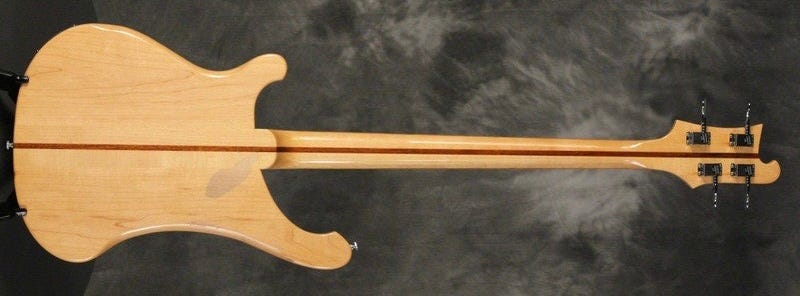
“At the same time the single pickup model 4000 changed from neck through construction to set neck. The 4001 would retain this three piece neck until it was discontinued in 1985. The 4002 would mimic the 4001 neck’s construction over its lifetime.”
Hey, that’s not bad for a first pass! I don’t think I have anything to add to that. You’ll note, however, that I specified the “solidbody 4000 series basses”. We’ll get to the 4005 in a minute. Let’s carry on.
“The 4003, introduced in 1979, featured the first two piece neck, with maple wings. In 1985 the neck would be changed to one piece.”
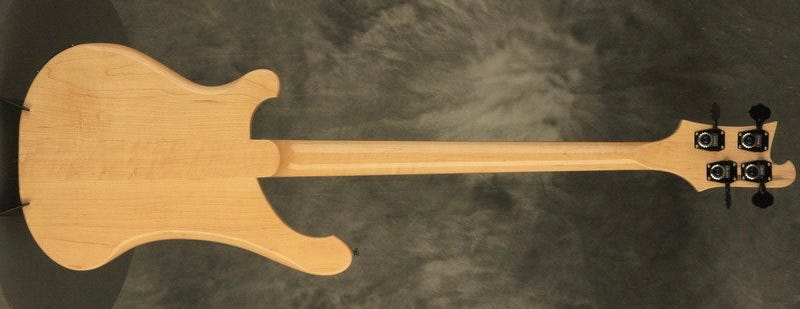
“Walnut headstock wings would replace maple in 2008. And, as with guitars, in 2009 the one piece maple neck would be replaced with a two piece center seamed maple neck.”
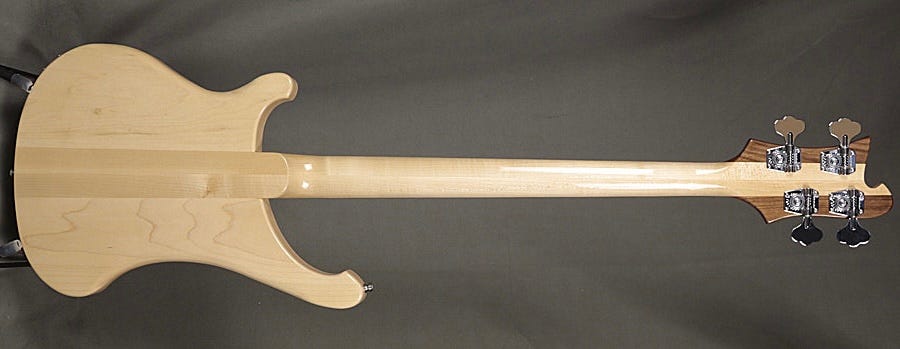
“In 2023 neck construction would revert to three pieces with a narrow walnut center “skunk stripe”, but with walnut headstock wings this time instead of maple. Variants like the 4030, 4003S/5 etc. follow the 4003 timeline/rules.”
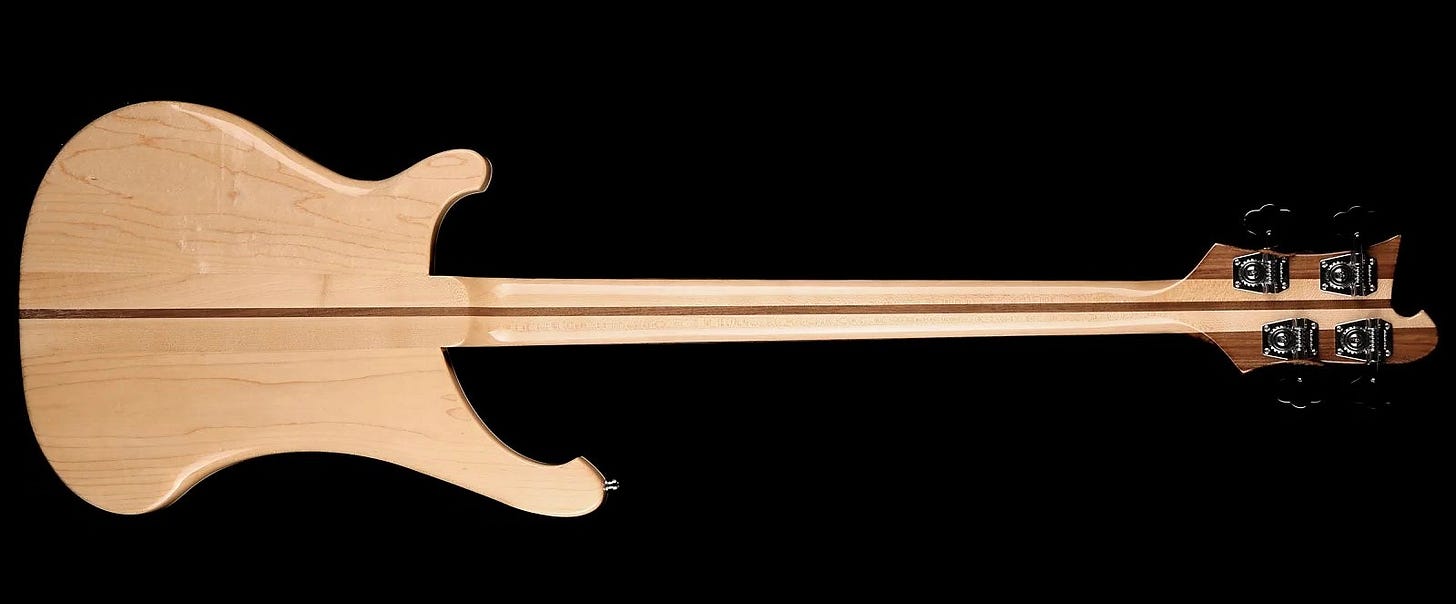
Clean, I like it. But we still need to talk about the 4004 and the 4005. “Upon the 4004’s introduction in 1993, the Cheyenne would feature a one piece maple through neck with walnut headstock wings. The Cheyenne and Cheyenne V2 would maintain this construction until 2009 when the neck was changed to two piece center seamed maple, and this would carry through until their discontinuation in 2017. The one exception to this rule would be that some (but not all) Cheyenne V2s produced prior to 2005 finished in Trans Blue, Green, or Red would feature highly flamed maple headstock wings instead of walnut.”
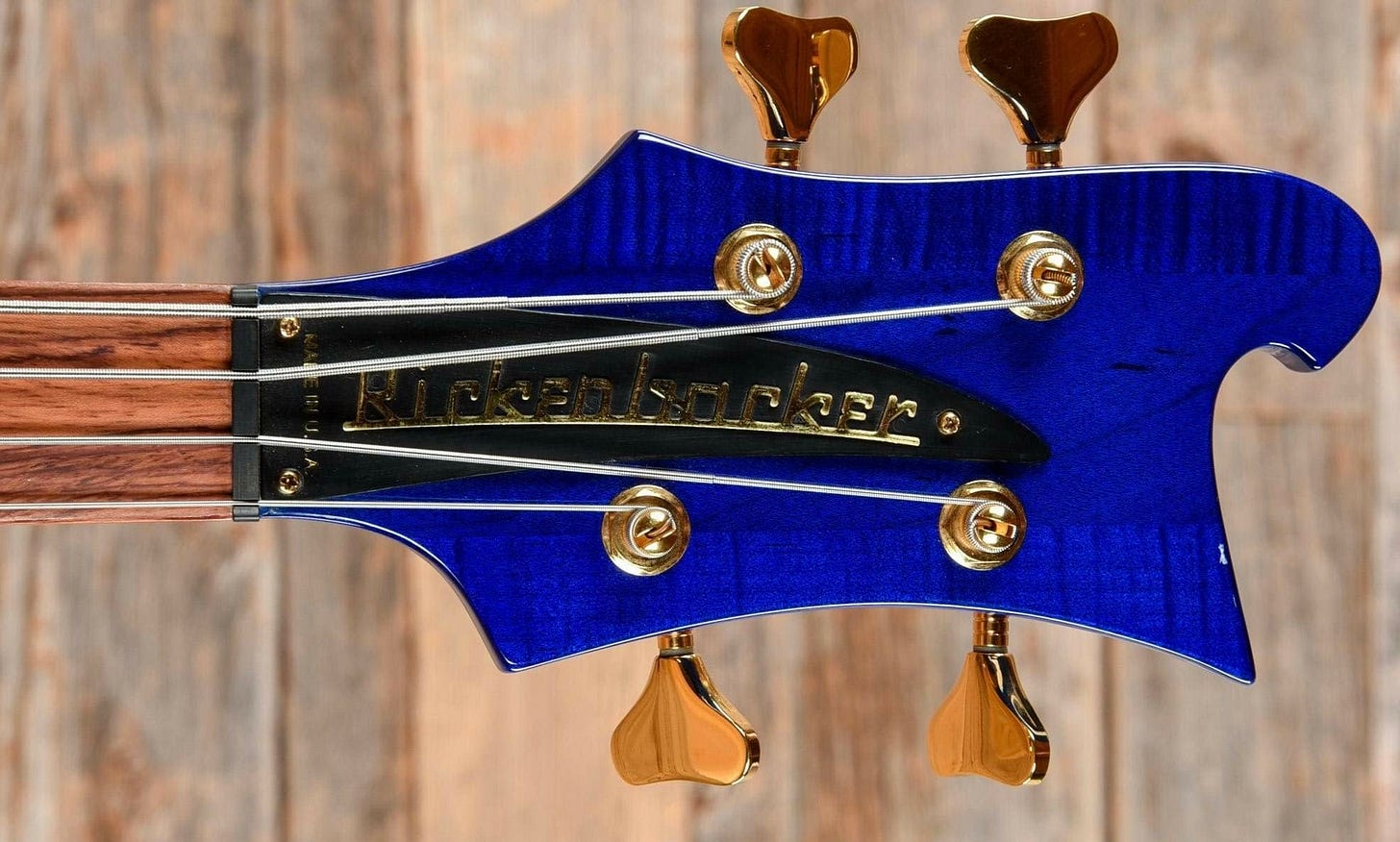
“The Laredo would mimic the 4003’s neck construction over its lifetime.”
And that brings us to the 4005. “When introduced in 1965, the semi-hollowbody 4005 used a three piece maple/walnut/maple with walnut headstock wings set neck similar to semi-hollowbodied guitars of the era.”
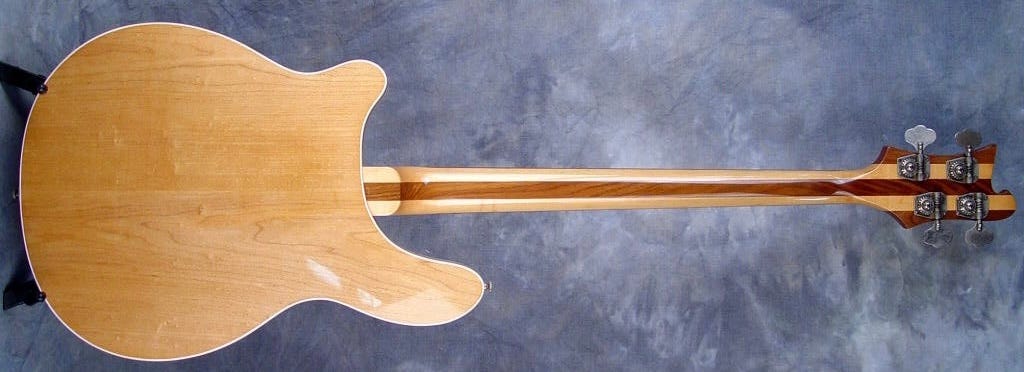
“4005s produced from 1972-1982 used the “skunk stripe” three piece neck with maple walnut wings as found on period 4001s.”
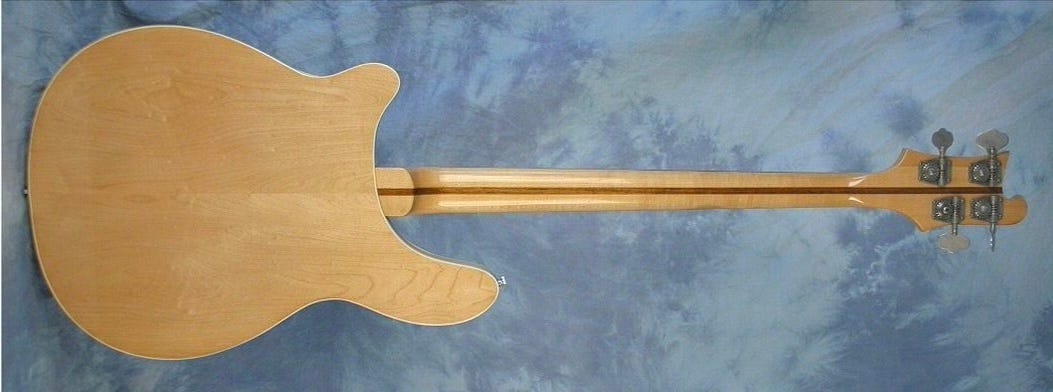
“When relaunched in 2024, it utilized the three piece “skunk stripe” neck with walnut headstock wings used on the period 4003.”
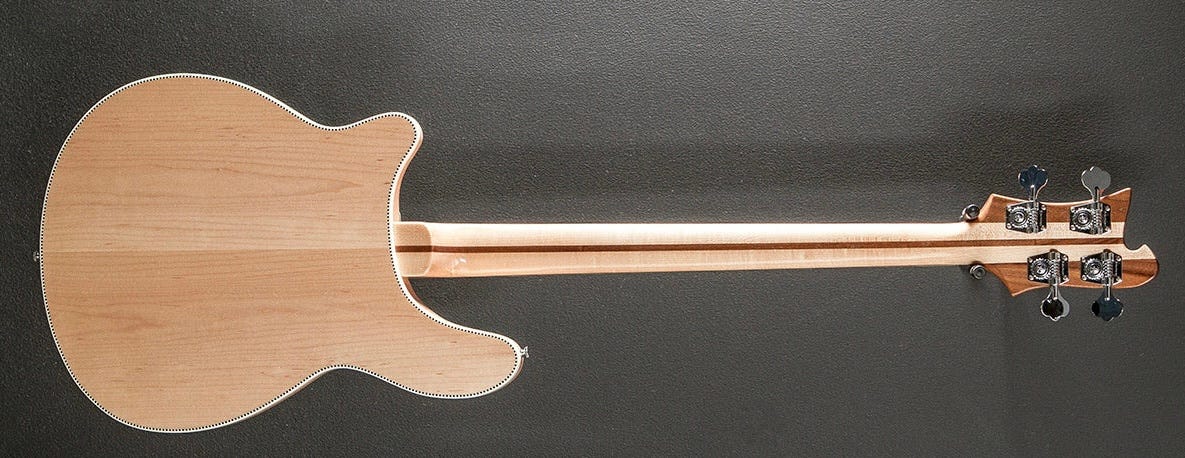
“The 90th anniversary 4005XC produced from 2021-2022 utilized this same neck”.
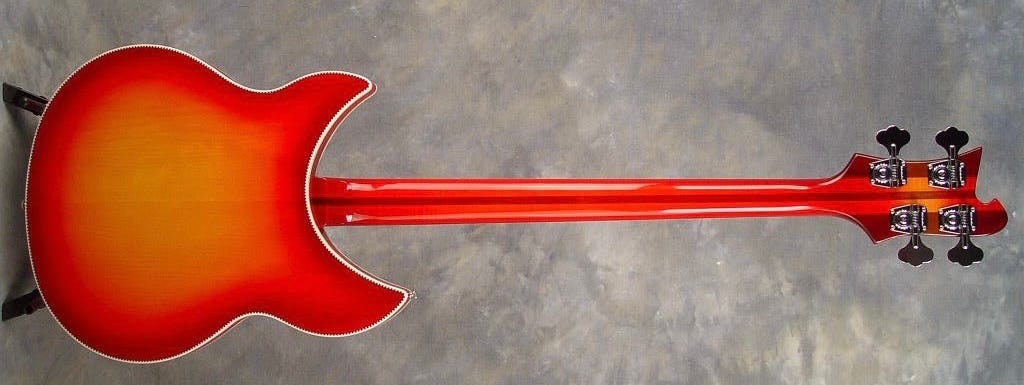
I mean, that makes sense, right? Use the bass neck you’re already making.
Ok, let’s wrap up the basses: “The 3000 series basses used period correct three piece “skunk stripe” bolt on necks with maple wings while the 2000 series featured one piece maple bolt on necks with maple headstock wings over their entire production runs”. Simple enough.

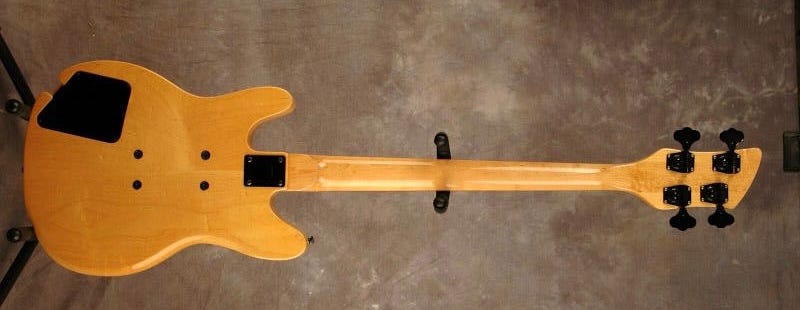
Are we done? No. There’s one oddity I left out that we need to cover before we’re done. The 4080. “The double-necked 4080 had necks that were both set and bolted on. The bass neck was the same three piece skunk stripe with maple headstock wings found on the period 4001. On six string versions, the one piece maple with maple headstock wings guitar neck found on the 480 was used.”

“On 12 string versions the three piece neck with narrow center stripe as found on period semi-hollowbodied guitars was used”.
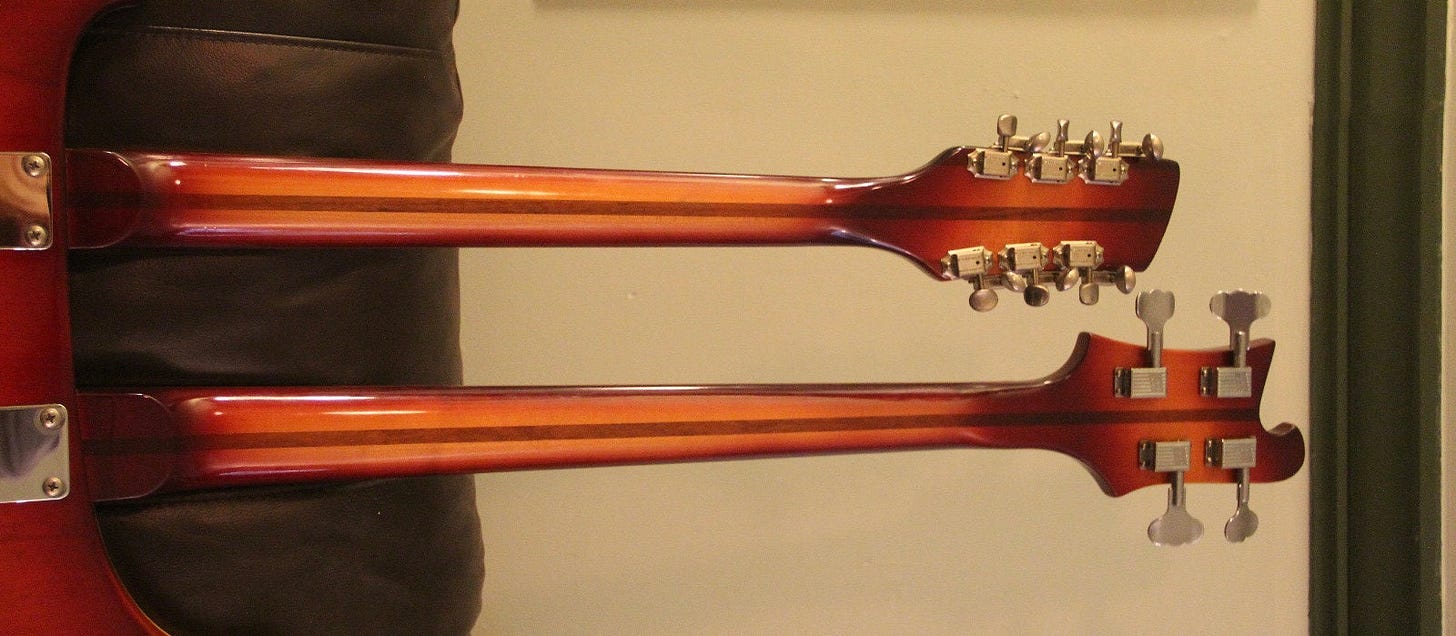
Which makes sense, right? Use the necks you already have, like we said earlier. And while you may not have noticed the import of this, it IS notable because this is the only PRODUCTION solidbody guitar ever to use a three piece “semi-hollowbody neck”. How about that?
Ok. That’s what we’ve got. Now you can read all of those stripes, or lack thereof! Tell me what I got wrong—because I’m sure I got something wrong—and I’ll fix it!


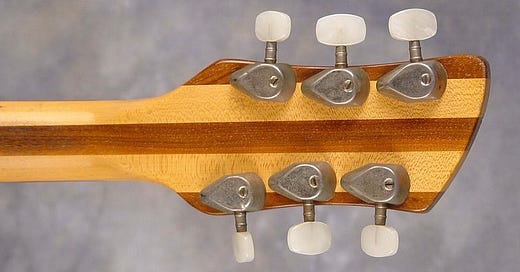

Love the detail, and the design layout looks great! Subscribed!
Andy, I'm not totally sure I followed all this, but here's an example of a two-piece neck on a 1982 4003S; check out the photos of the back to see the two pieces: https://www.rickresource.com/register/viewitem.php?id=18632 Oh, BTW, this is Ron OKeefe, if you can't tell from my "Vincent" handle!